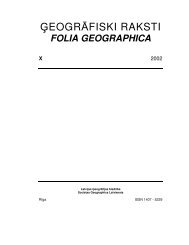eogrÄfiski raksti folia geographica xii - Ä¢eogrÄfijas un Zemes zinÄtņu ...
eogrÄfiski raksti folia geographica xii - Ä¢eogrÄfijas un Zemes zinÄtņu ...
eogrÄfiski raksti folia geographica xii - Ä¢eogrÄfijas un Zemes zinÄtņu ...
You also want an ePaper? Increase the reach of your titles
YUMPU automatically turns print PDFs into web optimized ePapers that Google loves.
HUMAN GEOGRAPHY<br />
Preliminary results of population mobility research in 2004 indicate several new trends.<br />
The commuting distance and time tend to be longer and, compared to the end of 1990s, the area<br />
of agglomeration is expanding [Department of human geography 2004]. At the same time,<br />
however, there is something else that is affecting changes in the lifestyle of a specific group in<br />
the population – the suburbanization processes that are common in Western co<strong>un</strong>tries are also<br />
taking place in Latvia. This is shown by the development of new areas of private bedroom<br />
comm<strong>un</strong>ities on the peripheries of large cities (especially Riga). At the same time an exurban<br />
type of settlement is emerging in beyond the immediate commuting range of cities.<br />
Conclusions<br />
Political, social and economic changes in the early 1990s in Latvia meant a f<strong>un</strong>damental<br />
shift in the volume and direction of international migration, and Latvia, which during Soviet<br />
times was an immigration-dominated republic, became an emigration-dominated nation.<br />
International migration in the early 1990s continued to be largely tied to the former Soviet<br />
territories, but during the last ten years this has diminished. A gradual shift toward greater<br />
migration flows to and from Western Europe and to developed co<strong>un</strong>tries beyond Europe has<br />
been occurring.<br />
The results from different studies and surveys indicated the stabilization of current<br />
migration flows and new types of migration, such as educational and seasonal, were observed.<br />
As mentioned before, future trends of labour migration processes will probably be influenced by<br />
EU enlargement and its impact on the economic situation on a new member states such as<br />
Latvia.<br />
The losses of resident population by migration differ in urban and rural areas. After a<br />
decade of dramatic changes in migration, internal rural- urban exchanges have normalized.<br />
Internal migration trends in the early 1990s, which saw flows of people from cities to rural areas<br />
and from the central part of the co<strong>un</strong>try to its peripheries, turned out to be only temporary.<br />
Beginning in 1998 the migration system began to return to the trends of the 1970s and<br />
1980s. The flow from rural areas to cities, and from peripheral areas to the Riga metropolitan<br />
area is once again dominant.<br />
The current mobility trends show that suburbs are developing, especially aro<strong>un</strong>d large<br />
cities. The intensity of daily commuting from suburban areas to the centres of cities today<br />
depends on the level of urban development and on the ability to adapt to the demands of the<br />
market economy. The suburbanization processes, which are common in Western co<strong>un</strong>tries, are<br />
also beginning to appear in Latvia.<br />
References<br />
Alberte, I., Burve, A., Sloga, G., Kasparāns, G., Diņģelis, M. (2004). Vienvirziena biļete uz<br />
rietumiem. Sestdiena. 3-9.04., 17-20. [One way ticket to the western co<strong>un</strong>tries]. In Latvian.<br />
Bauls, A., Krišjāne, Z. (2000). Latvian population mobility in the transition period.<br />
Ģeogrāfiski Raksti/Folia Geographica, 8, 24-35.<br />
Bauls, A., Melbārde, Z., Šķiņķis, P. (1999). Rīgas aglomerācijas robežu noteikšana nepilnīgas<br />
informācijas apstākļos. Ģeogrāfiski Raksti/Folia Geographica, 7, 85-93. [Delimitation of the<br />
borders of the Riga agglomeration with incomplete information]. In Latvian.<br />
Baltic Data House (2004). Data from public opinion survey. Unpublished.<br />
Clark, W.A.V., Kuijpers-Linde, M. (1994). Commuting in restructuring urban regions. Urban<br />
Studies, 31, 465-483.<br />
Department of Human Geography, University of Latvia. Cilvēka ģeogrāfijas katedra,<br />
Latvijas Universitāte (2000). A study of the largest urban areas. Unpublished. In Latvian.<br />
Department of Human Geography, University of Latvia. Cilvēka ģeogrāfijas katedra,<br />
Latvijas Universitāte (2004). A study of population mobility in the Riga agglomeration.<br />
Unpublished. In Latvian.<br />
72

















